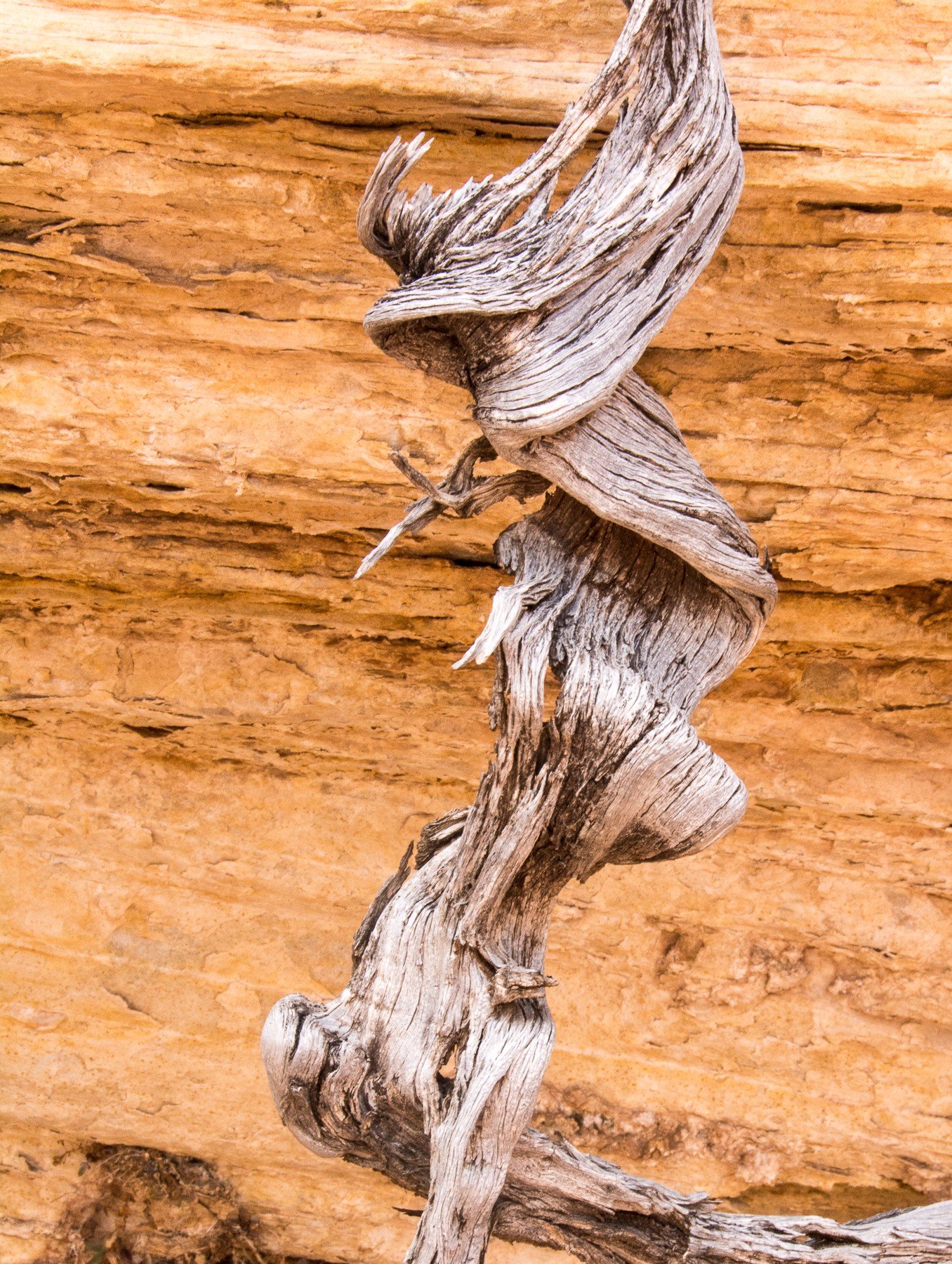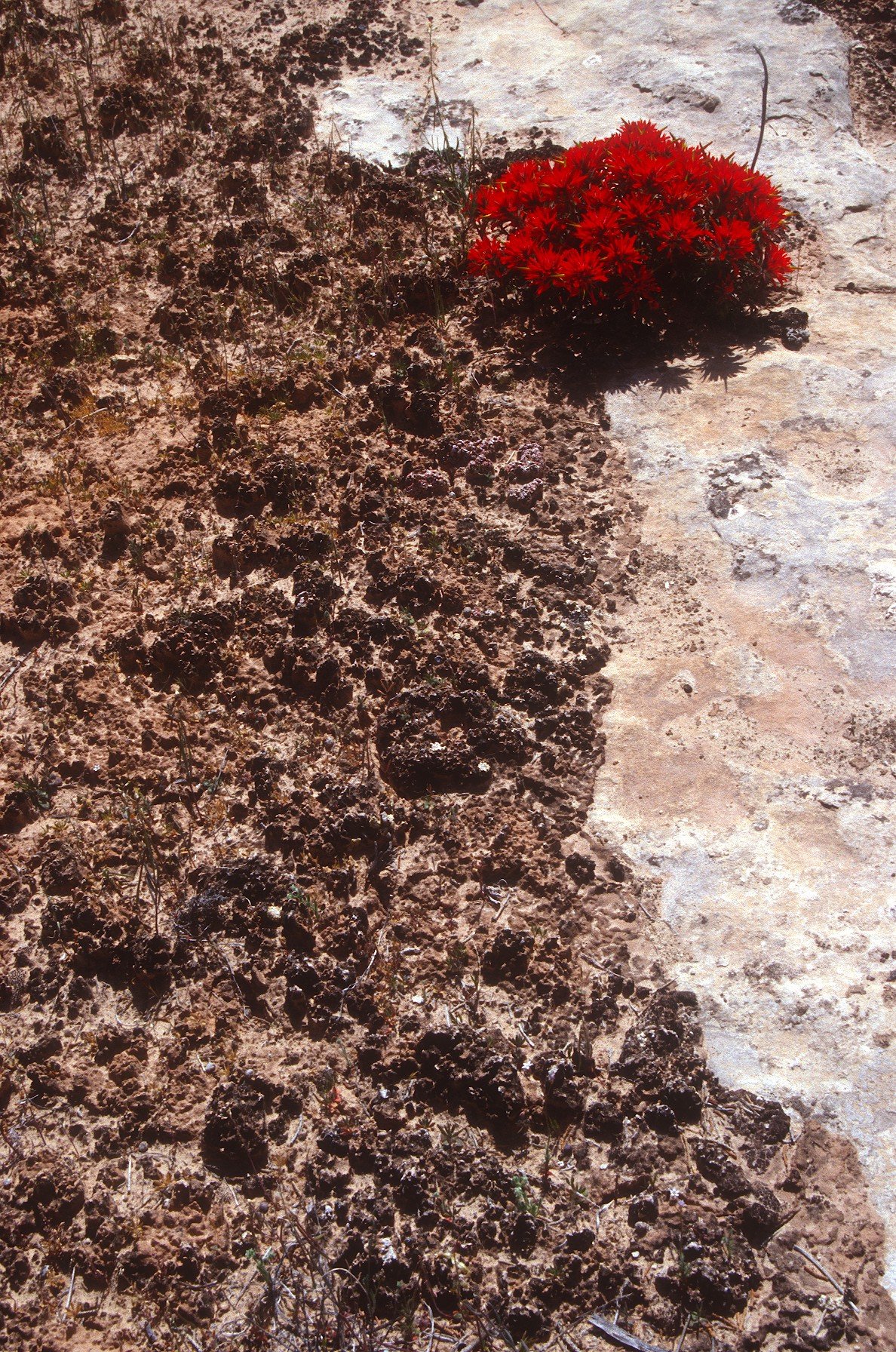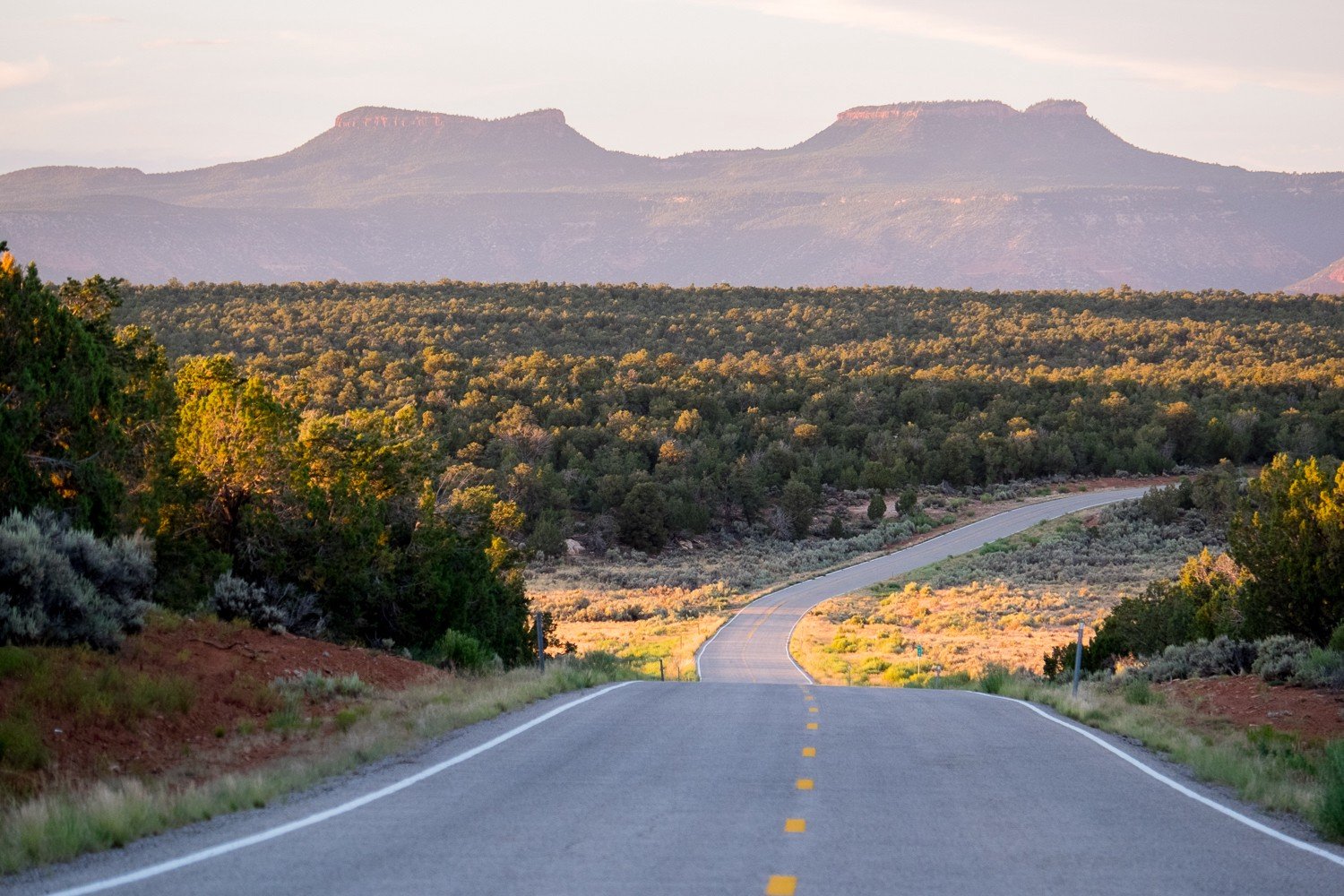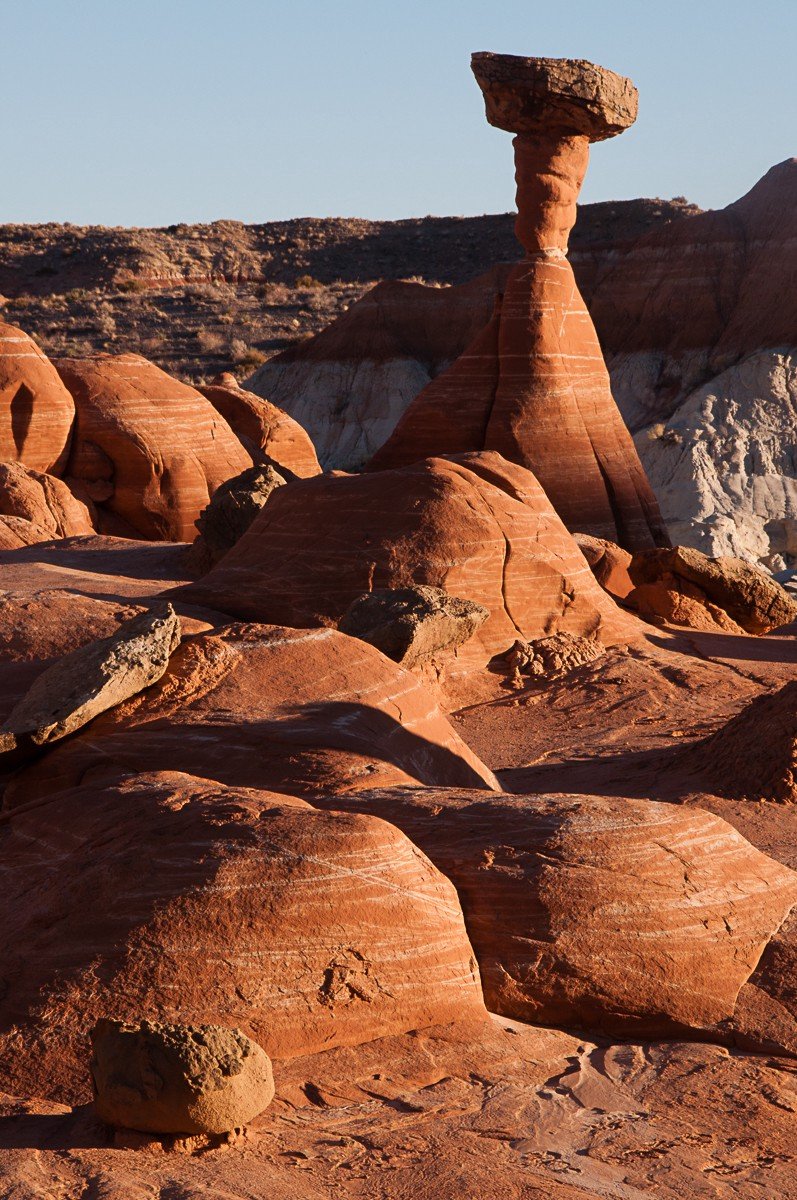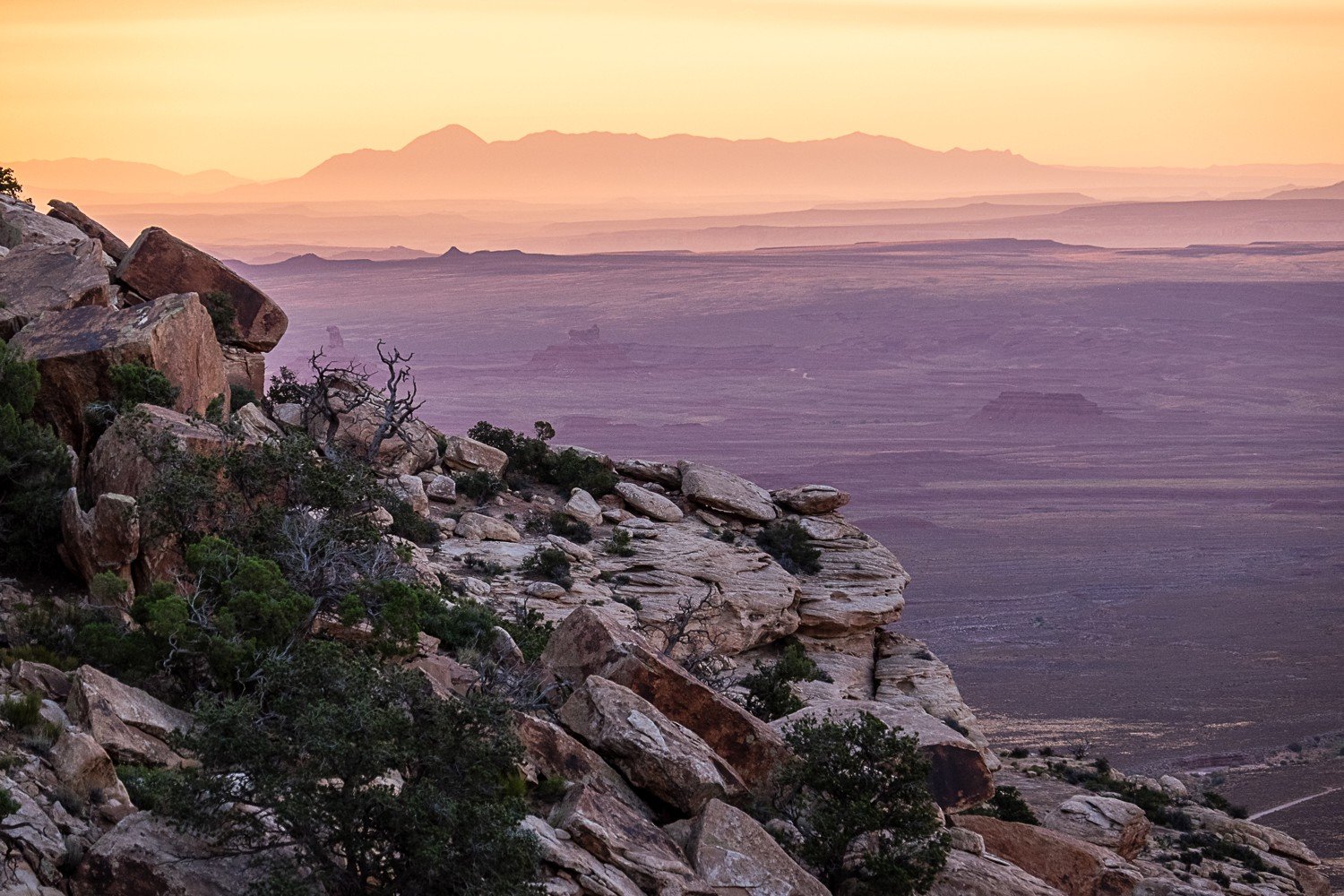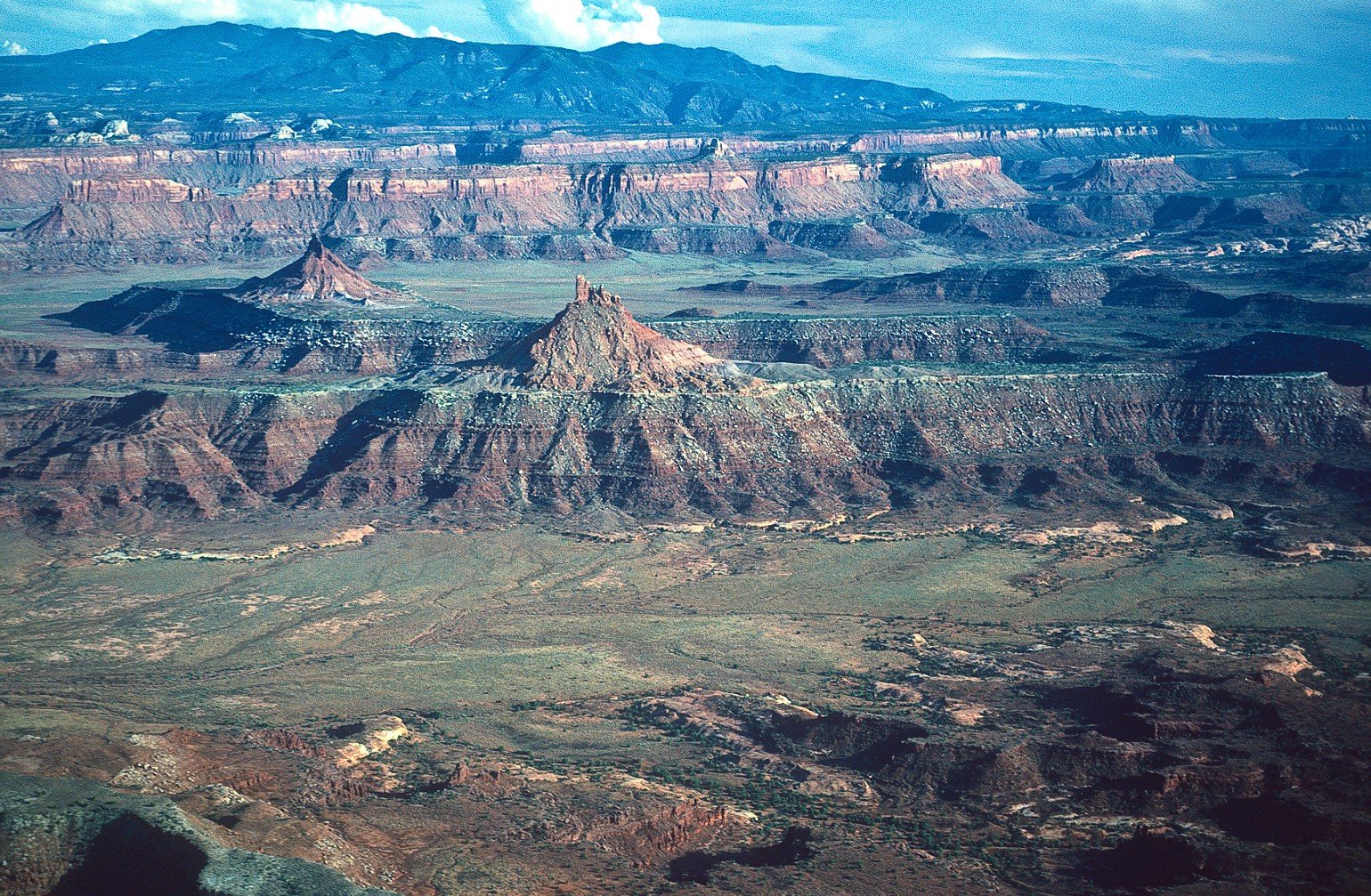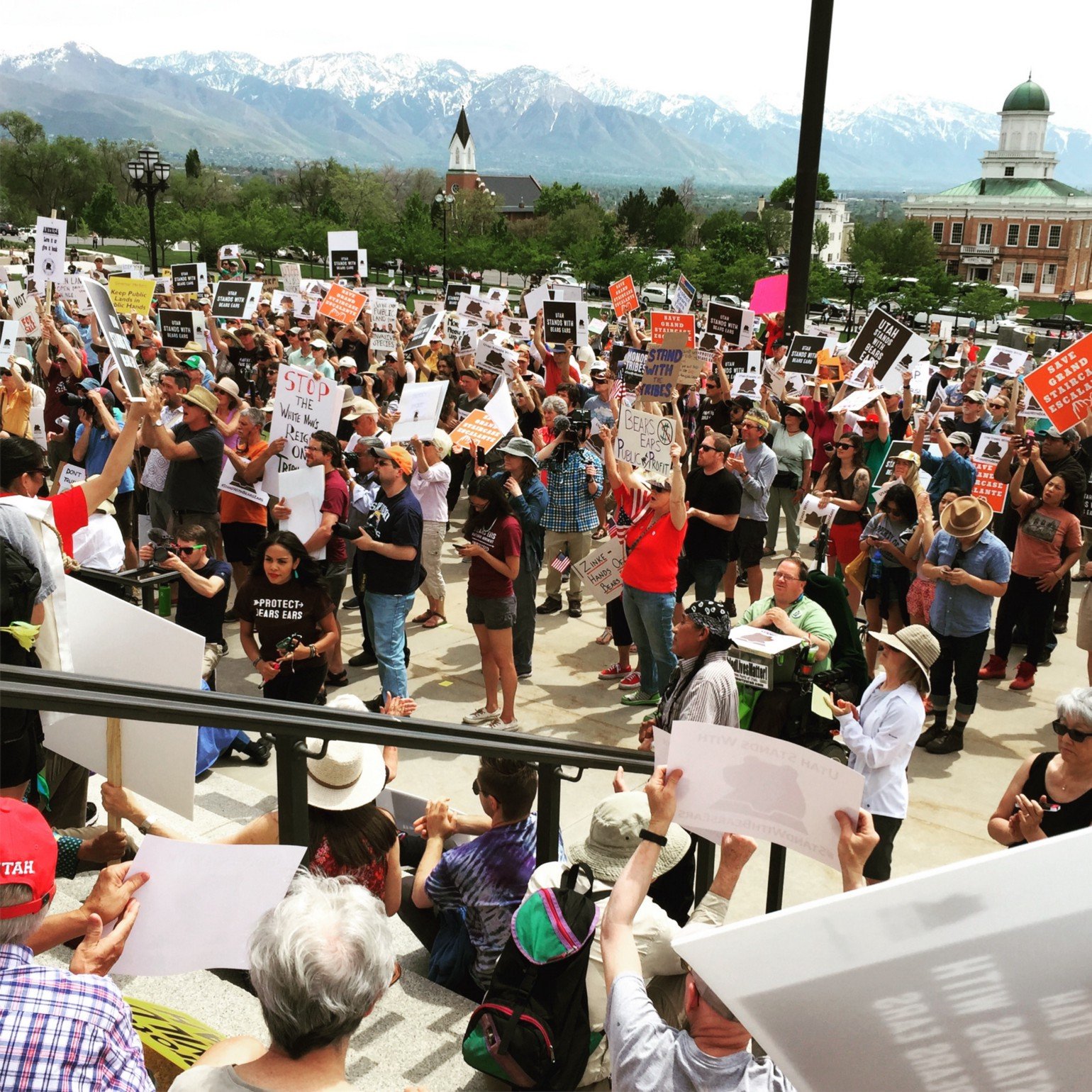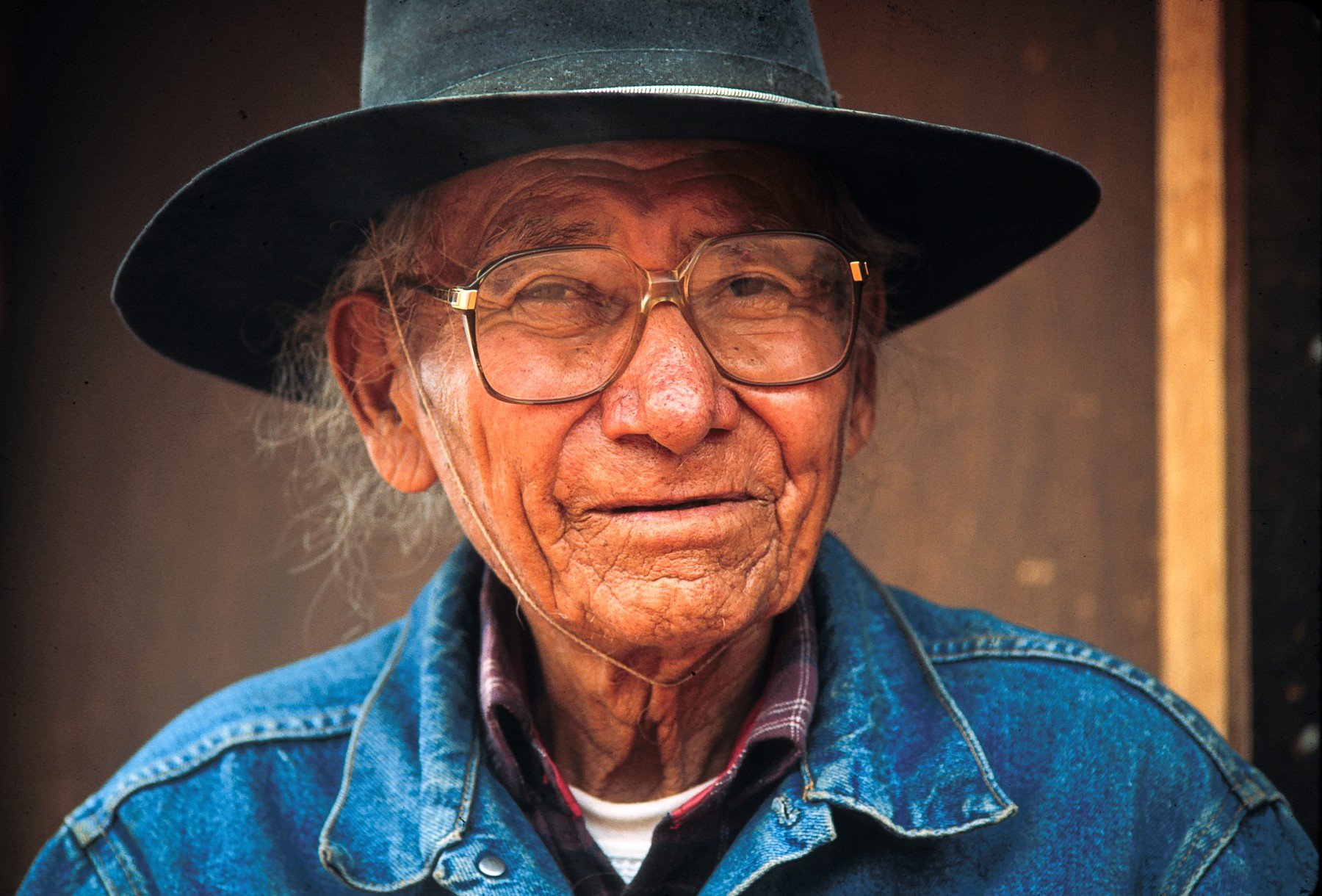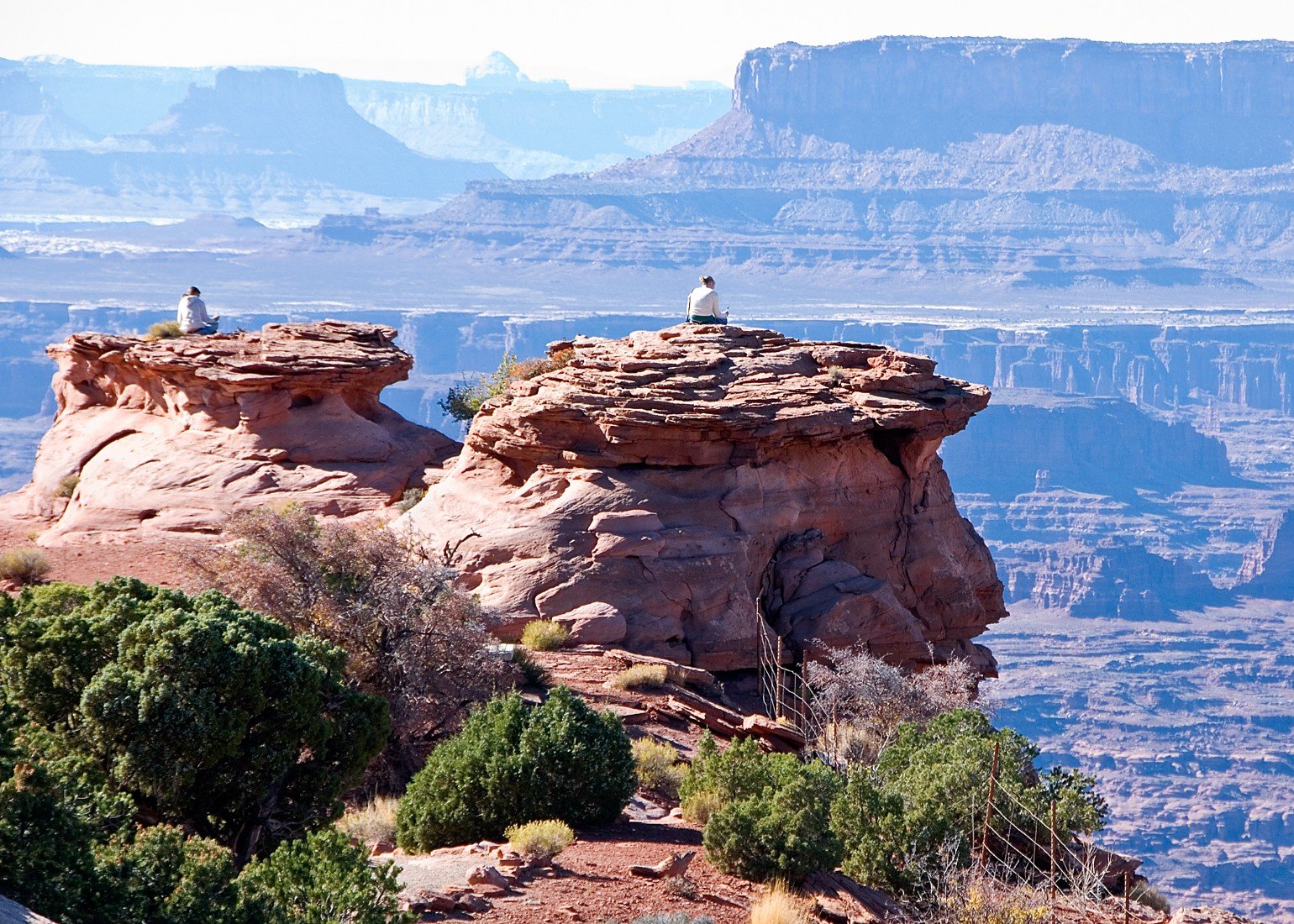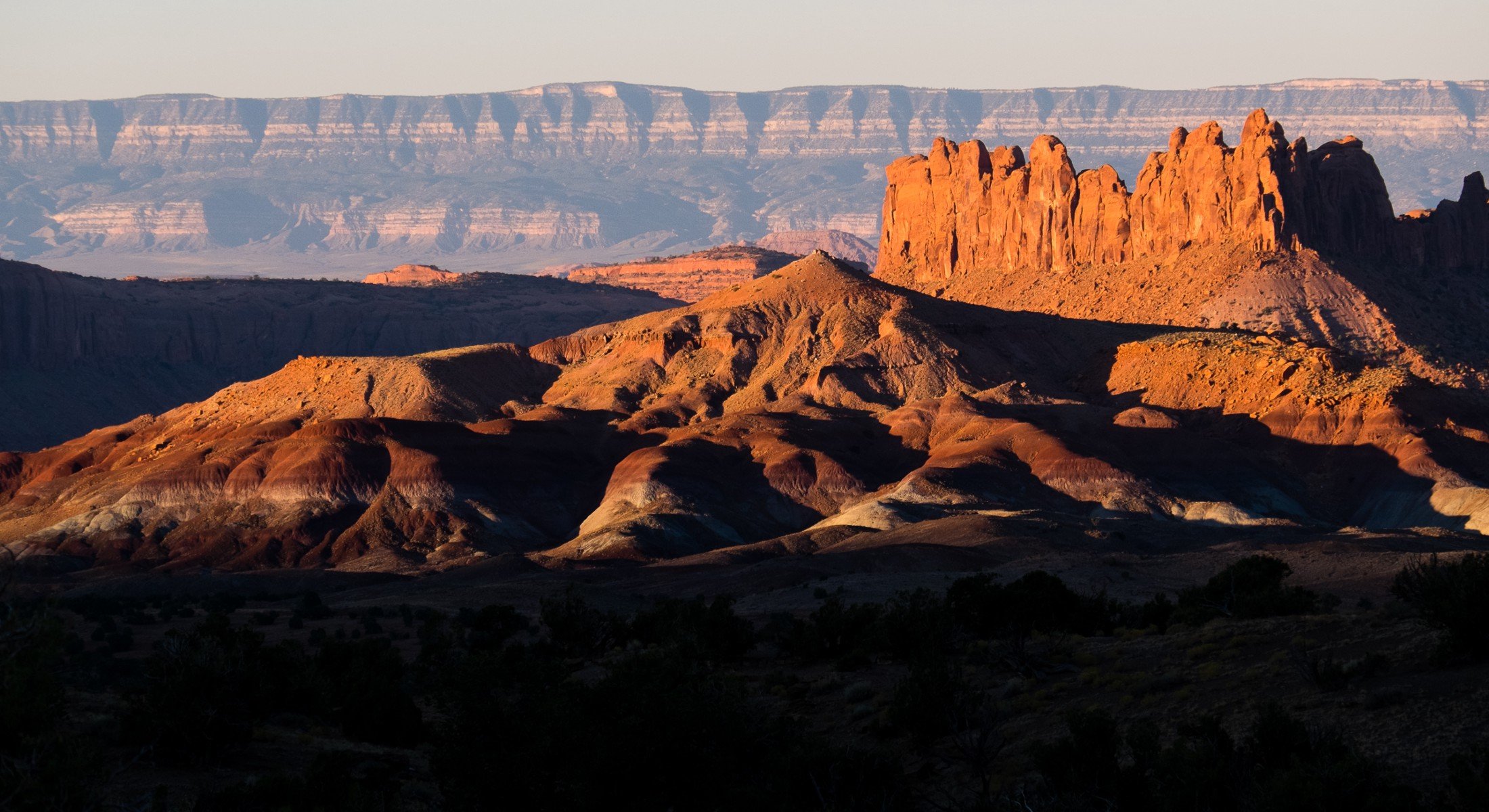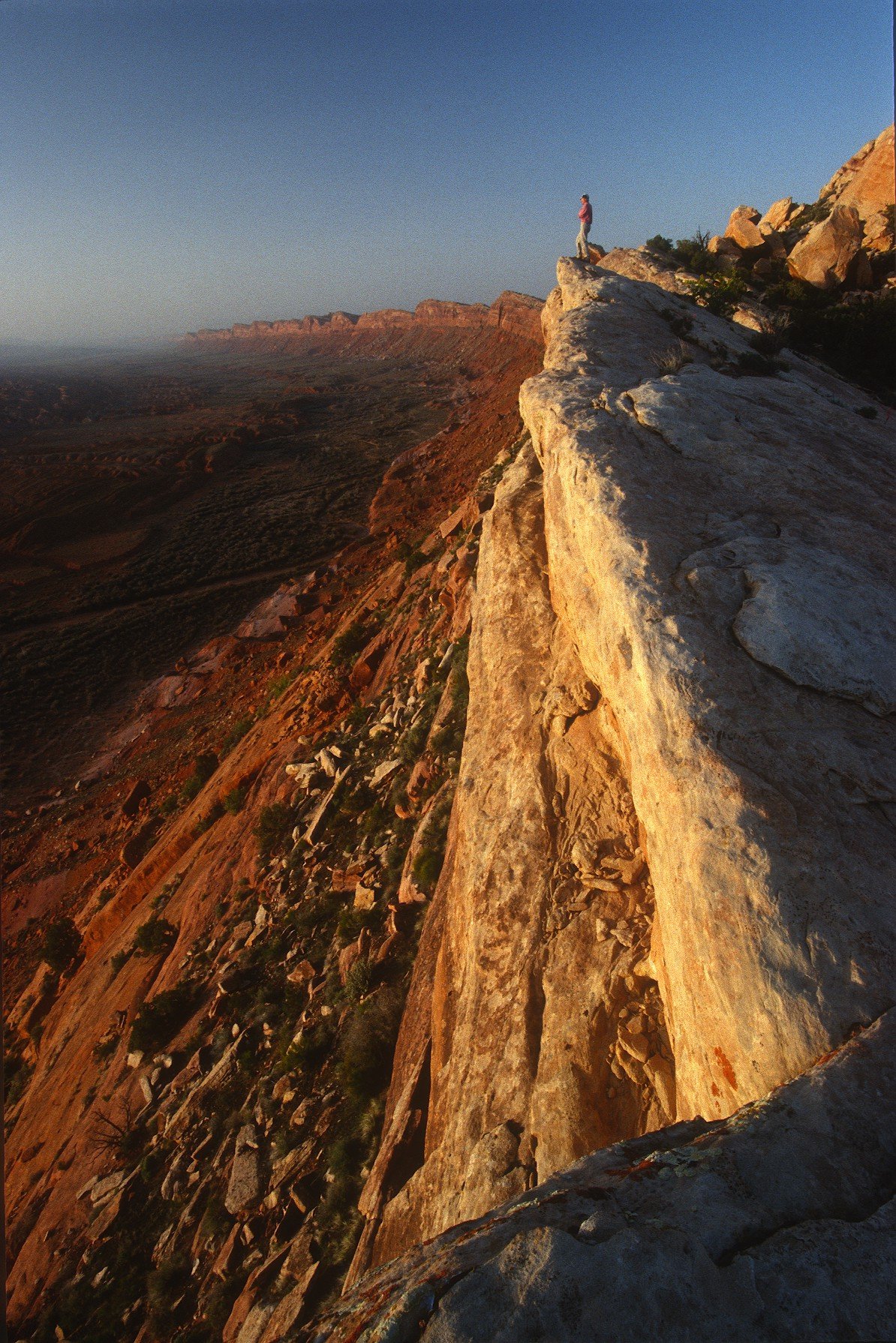I #standwithbearsears
(As the 45 days of Secretary Zinke’s “review” of #mymonuments tick down, I’m going to post a story and a picture nearly every day. I’ll post to Instagram, share on Facebook, and collate all of those here on Medium, so you can find every rant in one place! This will be my small gesture to #standwithbearsears and #standwithgrandstaircase Please share widely!
Remember, #monumentsforall!)
Day Twenty-Nine, May 25th
Dancing juniper snag, Cedar Mesa, Bears Ears National Monument, Utah. photograph © Stephen Trimble
This is the last day. Today. We have no more chances to speak to @SecretaryZinke about why we #standwithbearsears. Go to https://www.regulations.gov/comment?D=DOI-2017-0002-0001 and make your case.
Though the administration evidently is already drawing maps for a 90 percent reduction in protection for Bears Ears, we cannot be discouraged. Robert Gehrke wrote in the Salt Lake Tribune that “sources” say that “Trump will likely dramatically shrink the Bears Ears monument, down to two and possibly three parcels totaling fewer — possibly much fewer — than 150,000 acres.”
So why take the time to comment? Because justice takes a long time, but it comes. Because the current administration’s greed will prove short-lived. Because the Resistance needs our words. And when we end up in court, it will matter that tens of thousands of comments came to Zinke, running 100 to one for protecting the monument. Our wave of support for the tribes and for the land will matter.
So, go ahead. Submit your comments. You are a citizen. You speak for the future. Your voice counts.
Go to https://www.regulations.gov/comment?D=DOI-2017-0002-0001 and speak truth to power.
#standwithbearsears #standwithgrandstaircase #utahwilderness #monumentsforall #mymonuments #cedarmesa
Day Twenty-Seven, May 23rd
Bears Ears Butte, Cedar Mesa, Bears Ears National Monument, Utah. photograph @ Stephen Trimble
Will Bears Ears disappear into the clouds — a national monument only briefly, now to be diminished or denied by short-sighted political leaders?
Not if we speak up, in multitudes. Not if we stand with the tribes. To register your comment @SecretaryZinke, go to https://suwa.org/comment/ The deadline is 5pm ET Thursday, May 25.
In our new book, Red Rock Stories, Jim Enote, from the Pueblo of Zuni, says what needs to be said.
“In the spirit of a just transition to genuine and virtuous collaboration, a Bears Ears National Monument will enable tribal and federal authorities to reach out and enlighten on equal terms: to decentralize power and leadership and share problem solving. Rather than oppose each other, there will be opportunities to allow multiple knowledges to speak. Let us bury the fit-in-a-box orthodoxy of one structured and established system of lands management. By virtue of collaboration we will pay tribute to voices of the land and its antiquity, as it should be perceived and understood.
“One-third of the 130,000-square-mile Colorado Plateau lies within the sovereign nations of several tribes, and so if this nation proves itself to be truly egalitarian, we cannot base our efforts to protect our antiquities and natural resources in a single knowledge system. A Bears Ears National Monument will serve as a unique learning place where science and tribal traditional knowledge will work to manage Bears Ears equally, a place to evolve an informed and competent citizenry, a sanctuary for cultural, social, and intellectual mediation.”
#standwithbearsears #standwithgrandstaircase #utahwilderness #monumentsforall #mymonuments #cedarmesa
Day Twenty-Six, May 22nd
Cheryle Beecher’s daughter, Hualapai Reservation, Peach Springs, Arizona. photograph © Stephen Trimble
I’ve made my case for honoring Barack Obama’s decision to create Bears Ears National Monument. Please make yours. Go to https://suwa.org/comment/ The deadline is 5pm ET Thursday, May 25. If you comment at this link, SUWA will print out your comments and hand-deliver hard copy to @SecretaryZinke. Only your statement and name will appear on the printout; SUWA is just the messenger.
The secretary needs to listen to us. The Utah delegation does not speak for Utah citizens. A new (and conservative) poll shows that 64 percent of Utahans support the monument. The Utah delegation does not speak for America. The national press and public are overwhelmingly opposed to shrinking or rescinding Bears Ears.
So maintain our strong-hearted momentum. Raise your voices for all of us — especially for this gesture of respect toward Native America, represented here by my photograph of this Hualapai girl. Make sure your friends and family comment, as well. And be sure to send copies of your comments to your members of Congress.
I choose to listen to our last president, not our current one. In his second inaugural speech, Barack Obama asked “you and I, as citizens” to lift our voices “in defense of our most ancient values and enduring ideals.”
So. We will.
#standwithbearsears #standwithgrandstaircase #utahwilderness #monumentsforall #mymonuments #cedarmesa
Day Twenty-Five, May 21st
Don’t step on the biocrust! Cedar Mesa, Bears Ears National Monument, Utah. photograph © Stephen Trimble
Wander through slickrock. Follow the cross-bedded, water-polished, mineral-stained sandstone between swales where soil collects, deepening a centimeter every thousand years. Castellated nubs of what looks like black crud shield this precious soil with a grid woven by microorganisms that stabilize and fertilize and prevent erosion.
Flatten that soil crust and you disrupt a fragile network of life. The first footprint or first bicycle tire track or first cow hoof does most of the damage. A thoughtless ATV driver doesn’t see the wound he leaves when he guns his four-wheeler off-road. He sees adventure. But he and his friends create a fretwork of tracks that fragments habitat. Burly tires tear the skin of the earth, and this dry land loses its stability.
After a one-time trample, pioneering cyanobacteria, the first and tiniest organisms to colonize soils, might take a decade to recolonize. Early successional lichens can take 60 years; the most colorful mature lichens often never recover. Climate-stressed soil crust will need centuries to regenerate.
Sever the invisible threads holding the land together, wound the soil crust at the scale of widespread overgrazing and energy development, and all that newly-released dust blows eastward into the Colorado Rockies. Red dust settles onto alpine snowfields. Instead of brilliantly reflective white snow, the darkened surface soaks up extra sun and holds the heat.
Snowmelt in southwest Colorado now comes 50 days earlier than it did when we set up our system for delivering water to 40 million people downstream. Our reservoirs can’t store that overabundance of spring runoff, and so we lose water we’ll need later in the season. The thirsty citizens of Los Angeles need healthy and protected soil crust at the far end of the Colorado River system, in the canyonlands of the Bears Ears, to secure their irreplaceable drinking water.
Which is why Bears Ears National Monument matters for climate change, for climate justice, for the future of sustainable life in all of the Southwest, far beyond San Juan County.
#standwithbearsears #standwithgrandstaircase #utahwilderness #monumentsforall #mymonuments #cedarmesa
Day Twenty-Four, May 20th
The only recent well on Cedar Mesa. Thankfully, this one didn’t lead to a fracking field. photograph © 2015 Stephen Trimble
Strong words rang through the idea-filled space of Weller Book Works last night in our first reading for Red Rock Stories. Jana Richman spoke of the challenges of living in the divided town of Escalante, mirroring our divided country. Brooke Larsen talked about bicycling across the Colorado Plateau over the next two months, striking up conversations about climate justice wherever she goes.
Karen Shepherd described what it was like to serve in Congress. That experience, she said, changed every one of her molecules. Her call to action should send out every one of us to work on voter registration drives!
I loved listening to Anne Terashima read her piece about the joys and disasters of her Labyrinth Canyon river trip. I was looking past her into the audience at another young woman who was reacting with delight. I figured she was the character in Anne’s essay who forgot the keys to their shuttle car, leaving them no way to get back to their starting point when they pulled in to Mineral Bottom. I was right.
So what, says Anne? “Hearing about our trip, you might call it a disaster. But I’m left with the memory of vivid colors — of four young women in sunhats wading in water, walled by redrock and a boundless blue. I’m left with friendships strong with trust, my love for these friends rooted in toad-speckled sand and warmed by the sun, a trust shaped like we will figure this out and where to next? I’ve had many forays into wilderness since then, both with and without these friends. The awe does not diminish, it swells.”
Finally, our first Utah poet laureate, David Lee, held us rapt. Dave told us that he had an audience in mind when he wrote his contribution to Red Rock Stories. He wrote this poem for Barack Obama. We’ll have to figure out a way to get a recording to Barack of Dave savoring these words.
Dave’s prelude — with my photo of an exploratory well beneath the Bears Ears as illustration:
And the Voice said, “Moses did not go to an oil well derrick to receive the Law and the Tablets, and Jesus did not go to a fracking site to give The Sermon, and Buddha most certainly did not sit under a pump jack to experience the vision that changed the world forever. Sacred Place is required to receive Sacred Epiphany, and without that epiphany, wisdom cannot be achieved.”
#standwithbearsears #standwithgrandstaircase #utahwilderness #monumentsforall #mymonuments #cedarmesa
Day Twenty-Two: May 18th
The San Juan River forms the southern boundary of Bears Ears National Monument. photograph © Stephen Trimble
Friday night, May 19th, we hold the first readings for Red Rock Stories. One in Moab, at Back of Beyond Books, the other in Salt Lake City at 7:00 at Weller Book Works in Trolley Square.
I’ll narrate the story of our book in Salt Lake. Joining me: former Utah Congresswoman Karen Shepherd, David Lee (first Poet Laureate of Utah), Brooke Larsen (the youngest of our contributors, a climate justice advocate), novelist and Escalante resident Jana Richman, and Anne Terashima, another millennial writer, to keep us old folks honest.
When I talk about the book, I often choose lines from Kathleen Dean Moore’s essay. She is the amazing emeritus professor of philosophy from Oregon State University who has left academia to devote herself full-time to climate justice.
Kathy Moore wrote her piece while she camped along the goosenecked canyons of the San Juan River during a five-day float trip. She fired off her draft the moment she reached cell service. These canyons, seen here, now bound Bears Ears National Monument.
Kathy asks a crucial question about our children: “What will be our legacy for those who have no voice to shape their own destinies — what chance of gladness, what landscapes of enduring, bedrock value?”
These excerpts from her essay hint at her eloquent answers.
“Let us give the children wonderment, radical amazement at the mysteries of the desert on this majestic scale and in this microscopic exactitude, the expanse of the stars, the polliwogs in plunge pools. These are wonderful beyond imagining.”
“Let us give the children a landscape that will not be despoiled, an expanse of land that will never be defiled, bulldozed or burned, never taken as spoils in a war against the world or sold off in a giant going-out-of-business sale. Here…the landscape will be proof of the possibility of human restraint.”
#standwithbearsears #standwithgrandstaircase #utahwilderness #monumentsforall #mymonuments
Day Twenty-One: May 17th
Bears Ears from Valley of the Gods, layer after layer after layer. photograph © Stephen Trimble
Paleontologists love Grand Staircase-Escalante National Monument. They are eager to fully explore Bears Ears. I love the mystique of fossil-hunting, and I often said I wanted to be a paleontologist when I was a kid. The closest I came was helping excavate a Kritosaurus in New Mexico’s Bisti Badlands with a Museum of Northern Arizona field crew when I was 30. The experience was just as cool as I thought it would be when I was eight.
GS-E has yielded over a thousand new fossil sites producing tens of thousands of new fossil specimens in the 21 years since designation. These include twenty new species of dinosaurs, marine reptiles (plesiosaurs), crocodilians, turtles, lizards, mammals, and fish. Many of these come from the Kaiparowits Plateau — the very place that the Utah delegation wants to remove from Grand Staircase, the very place that Chris Stewart and Orrin Hatch imagine transforming into a coal mine.
As the Utah Friends of Paleontology say of GS-E, “These important discoveries would not have been made if it weren’t for the framework for resource protection and scientific study put in place by the establishment of the monument.”
These scientists anticipate the same fossil bonanza from Bears Ears, and they need the same resource management and protection to accomplish their research. Within Bears Ears, they’ve already discovered Paleozoic reefs, large carnivorous amphibians and early mammal relatives from before the time of dinosaurs, plants, invertebrates, fish, amphibians, reptiles, early Triassic dinosaurs, and giant long-necked sauropods from the Late Jurassic.
As President Obama’s Bears Ears proclamation says, “The paleontological resources in the Bears Ears area are among the richest and most significant in the United States.”
@SecretaryZinke, do you see any good reasons in these facts to withdraw protection for these unique and irreplaceable resources?
#standwithbearsears #standwithgrandstaircase #utahwilderness #monumentsforall #mymonuments #valleyofthegods
Day Twenty: May 16th
Trail of the Ancients Scenic Byway, Cedar Mesa, Bears Ears National Monument, Utah. photograph © Stephen Trimble
You can see the Bears Ears buttes from a long ways off. Truly a regional landmark, they make a fine symbol for Bears Ears National Monument.
But the monument is far more than the forested ridges surrounding Bears Ears. From the Goosenecks of the San Juan River to the forests of the Abajo Mountains, from the slots and slickrock of White Canyon to the buttes and towers in the Canyonlands Basin, from the crack climbs in Indian Creek to the archaeological treasures of Cedar Mesa — the monument’s diversity is astonishing.
And that’s the point. The Bears Ears is big for all kinds of reasons, but preserving biodiversity and the opportunity to conduct research along that full elevational gradient is one crucial reason for the monument’s size.
The five Native nations in the Bears Ears Inter-Tribal Coalition give us another clear argument for leaving the monument’s boundaries as the proclamation created them. Interviews with dozens of tribal elders document their multiplicity of ties to this land beyond reservation boundaries. These elders question the monument’s size, too, but their query would not be “why so big?” but “why so small?”
The Obama administration deferred to the Utah delegation when creating the monument. The proclamation follows the boundaries in Utah congressmen Bishop’s and Chaffetz’s Public Lands Initiative, which envisioned a Bears Ears National Conservation Area here, with weaker protections for the land. The monument boundaries leave out all lands with oil & gas or uranium potential.
@SecretaryZinke, please listen to your mentor, Teddy Roosevelt, who looked at the big canyon not so far downstream from Bears Ears — Grand Canyon — and said, “Leave it as it is.” T.R. would say the same about Bears Ears and Grand Staircase.
#standwithbearsears #standwithgrandstaircase #utahdinebikeyah
Day Nineteen: May 15th
The Toadstools, near Big Water. Grand Staircase-Escalante National Monument, Utah. photograph © Stephen Trimble
Grand Staircase-Escalante National Monument contains such diversity, it’s hard to pick an iconic image to identify the place. Message-makers have featured accessible and graphically bold features: the Toadstools (seen here), Metate Arch in Devil’s Garden, Calf Creek Falls, Grosvenor Arch. Or big scenes — Highway 12 winding through bowls of slickrock. Yellowstone (Old Faithful) and Arches (Delicate Arch, of course) have it easy.
It’s hard to convey the essence of 1.9 million acres in a single photograph.
And that’s the point of Grand Staircase. It’s big for a reason. When U.S. Geological Survey ecologist Jayne Belnap was “called in” to Washington D.C. to help draw the boundaries for GS-E, she did so as a scientist. She has guided me through her reasoning.
Where she could, she ran boundaries around whole plateaus and canyon systems. The Kaiparowits Plateau, a huge, wild, remote roadless area. The dissected sandstone wonderland of the Escalante slot canyons. The giant elevation gradient, with cliff-barricade risers and plateau treads, christened by pioneer geologists the “Grand Staircase.”
“A lot of those weird extensions to the boundaries are for research on substrates,” she says. “All that speciation is going on across vast expanses of weird habitats. I wanted to replicate each substrate and migration route from higher to lower elevations three times.”
This big-picture “large landscape conservation” requires vision, comprehensive knowledge, and boldness. In return, we get the chance to manage whole, healthy landscapes. We conserve key connections between forests and mountains. We have room to adapt to climate change and encourage resilience.
As the BLM web page for GS-E says, “The Monument’s size, resources, and remote character provide extraordinary opportunities for geologists, paleontologists, archeologists, historians, and biologists in scientific research, education, and exploration.”
@SecretaryZinke, size matters. Shrink Grand Staircase-Escalante or Bears Ears and you attack their defining reasons to exist.
#standwithbearsears #standwithgrandstaircase #utahwilderness #monumentsforall #mymonuments
Day Seventeen: May 13th
Wall Ruin, Mule Canyon. Bears Ears National Monument, Utah. photograph © Stephen Trimble
If @SecretaryZinke kept riding his horse up Mule Canyon beyond House on Fire Ruin, he would have come to ruin after ruin after ruin, including Wall Ruin, seen here. Archaeologists have told me that San Juan County was more densely populated a thousand years ago than it is today. Too bad those Ancestral Puebloan people aren’t still here. We could use their votes!
Bears Ears National Monument contains more than 100,000 cultural and archaeological sites, making it the most significant unprotected archaeological area in the country — until its designation six months ago. These sites testify to a long relationship with the country. Native people from surrounding tribes still think of this land as home. The Bears Ears Inter-Tribal Coalition proposal put it this way: “By visiting Bears Ears, giving our prayers, and conducting our ceremonies, we heal our bodies and help heal the land itself.”
That’s what makes this sacred land — those deep roots, that continuous history.
Like our visits to any wildland, we non-Indians revel in our own exhilarations in these canyons. But at Bears Ears, we’re aware of all of those ruins and graves. We know contemporary Indian people are still intimately connected to this place. When we come here to hike and climb and run rivers, we acknowledge that deep relationship with the earth that forms the core of the Native experience. Here, we pay our respects to Native America.
The tribes invite us to this participation. Jim Enote, from the Pueblo of Zuni, believes “that tribal peoples of this region shouldn’t be the only ones to take responsibility for protecting the cultural resources; they belong to everyone, and everyone should take responsibility for protecting them.”
#standwithbearsears #standwithgrandstaircase #utahdinebikeyah #cedarmesa #ancestralpuebloan #cliffdwellings
Day Sixteen: May 12th
The geography of hope, as seen from Boulder Mountain, Utah. photograph © Stephen Trimble
In our fight for #monumentsforall, it’s time for all of us to submit official comments. Go to https://www.regulations.gov/comment?D=DOI-2017-0002-0001 and make your case.
We have models for this moment. In 1958, Congress created the Outdoor Recreation Resources Review Commission to look at public lands recreation to “…ensure that the needs of the present and future are adequately and efficiently met.” The Commission asked for public input in 1960 and released its report in 1962. That 1960 request for comments led Wallace Stegner to sit at his desk in Los Altos Hills one December afternoon and articulate how he felt about “the wilderness idea, which is a resource in itself.”
In that afternoon of thinking and writing, Stegner created what we call the “Wilderness Letter,” now part of the bedrock of American literature. He organized his thoughts around the view from Boulder Mountain that had meant so much to him in his youth — this view, looking out over Grand Staircase-Escalante and toward the Bears Ears, off there behind the Henry Mountains. Stegner wrote himself into a soaring last paragraph that ends with, “We simply need that wild country available to us, even if we never do more than drive to its edge and look in. For it can be a means of reassuring ourselves of our sanity as creatures, a part of the geography of hope.”
In contrast to such careful deliberation on the part of land managers, in the current administration the Bears Ears comment period ends two weeks from today, on May 26. But save the best parts of your Bears Ears draft — we’ll have until July 10 to comment on the attacks on our other national monuments.
Words can change the world. Four years after Stegner spoke up as a citizen, Congress passed the Wilderness Act. Flood @SecretaryZinke with the clear reasons why Bears Ears is a remarkable conservation achievement, an act of healing in our fractured society, and a gift to the future. Ready? Write!
#standwithbearsears #standwithgrandstaircase #mymonuments #utahwilderness
Day Fifteen: May 11th
The whole country — sunrise across the Valley of the Gods and the Navajo Nation to Sleeping Ute Mountain. From Muley Point, Bears Ears National Monument, Utah. photograph © Stephen Trimble
Today it seems entirely appropriate to post the text of my letter to the editor in the Salt Lake Tribune this morning, May 11th.
The Utah delegation manipulated the president into signing an aggressive executive order demanding review of our recently proclaimed large national monuments. Sen. Orrin Hatch was “relentless,” in the president’s words. Citizens must be equally relentless in defense of these remarkable places.
Rep. Rob Bishop’s contribution to this campaign of misinformation is jaw-dropping. In The Tribune (May 3), he says of Bears Ears: “No local tribe in San Juan County, Utah, supported this designation.” Bishop knows better.
The Utah political elite foregrounds one Navajo woman who energetically repeats their talking points, San Juan County Commissioner Rebecca Benally. The delegation acts as if Benally speaks for the Navajo Nation. She does not. More than half of San Juan County citizens are members of the Navajo Nation. Six of seven of their Utah chapter-houses (the primary community unit of the Navajo Nation) support the Bears Ears monument. The Navajo Tribal Council supports the monument. Navajo Tribal President Russell Begaye speaks eloquently on behalf of Bears Ears.
The Ute Mountain Ute Tribe, which also includes San Juan County residents, supports the monument.
The delegation contorts the facts to argue that we should abolish or shrink Bears Ears National Monument. Either would be an egregious act of disrespect to native people and an attack on tribal sovereignty.
Stephen Trimble, Torrey
#standwithbearsears #standwithgrandstaircase #monumentsforall #mymonuments #navajonation #valleyofthegods #utahwilderness
Day Fourteen: May 10th
Calf Creek. Grand Staircase-Escalante National Monument. photograph © Stephen Trimble
@SecretaryZinke left Utah today with only one side of the story. Utah politicians stayed glued to him throughout his time here, controlling his conversations. He heard a few snippets from regular citizens and from Native people. But the anti-Federal, anti-anything-connected-with-Obama elected officials filled his ears with days worth of misinformation.
There’s a long history of opposition to national monuments in the West, and a long history of regret. When Wyoming governors Cliff Hansen and Alan Simpson opposed Jackson Hole National Monument in the 1950s — and even managed to pressure Congress to ban further Antiquities Act national monuments in the state — they later admitted they regretted their position. (Jackson Hole NM was absorbed into Grand Teton NP — an obvious economic bonanza for the state.)
After LBJ expanded Capitol Reef National Monument by sixfold in 1969, Boulder, Utah, briefly renamed itself “Johnson’s Folly” in protest. With the businesses in town today completely and delightedly reliant on GS-E and Capitol Reef-bound tourists, they don’t see that designation as folly now.
Zinke refused to meet with most of these new Westerners. The Utah congressional delegation made sure he met only with their select few, the old-timers who still believe that the old-times were great, that we can live as we did in a rural Utah of the 1930s.
That’s an admirable heritage. But it’s the past. #monumentsforall and tribal sovereignty and $billions in outdoor recreation and conservation biology and climate justice and accelerating archaeological vandalism and amenity migrants and renewable energy and loss of biodiversity and nature deficit disorder — this is the present.
As a thoughtful resident of Escalante once said to me of his hometown,
“Welcome to the 21st century, Escalante; we’re sorry you missed the 20th.” Walk into Grand Staircase-Escalante’s Calf Creek and chat with the folks you meet along the way. You’ll see what this fellow meant. Remoteness has turned into refuge.Secretary Zinke, welcome to the 21st Century, with all its complications. You can’t take us back to the 19th century. We won’t let you.
#standwithbearsears #standwithgrandstaircase #mymonuments #utahwilderness
Day Thirteen: May 9th
Looking past the Six-Shooter Peaks across Canyonlands National Park and Indian Creek to the Abajo Mountains. Bears Ears National Monument, Utah. aerial photograph © Stephen Trimble
Everyone loves The Nature Conservancy, our most careful and conservative conservation organization. They have accomplished much in Utah under the incredibly effective leadership of longtime state director Dave Livermore.
The Nature Conservancy also happens to be the biggest private landowner within Bears Ears National Monument.
TNC bought Dugout Ranch from Heidi Redd in 1997 (5,247 deeded acres and grazing permits on 320,000 acres of BLM, USFS and State of Utah lands). They’ve since created the Canyonlands Research Center at the ranch along Indian Creek, yes, that Indian Creek, the world-class climbing destination right next to Canyonlands National Park.
Heidi Redd told me in a 2008 interview, “Indian Creek is in my heart, in my soul. I don’t know that I ever would have been able to live with myself had the ranch ever been sold for development. One of the reasons why the ranch is such a good place for a science center is that we go from an alpine environment to the desert, where we border the Colorado River. I border a national park where there is no grazing, and I’m grazing. And so I’m excited that the ranch can be a tool for answering questions like how the grasses will change with global warming. It will benefit not just me as a rancher, but mankind.”
@SecretaryZinke is meeting with Dave Livermore and Heidi Redd at Dugout Ranch today. He’s going to hear the official TNC position from them: “There is no need to alter BENM.”
TNC emphasizes moving forward, not backward, to “do what is best for the resource” to work together with the tribes, agencies, and all stakeholders “to ensure the proper management and stewardship” of the monument.
This calm and clear-eyed argument comes from people who can be described as landowners, as local ranchers, as conservationists, as scientists — and as business people, since major leaders from corporate America sit on TNC state and national boards. They speak as Americans with a broad vision.
Listen to them, Secretary Zinke.
#standwithbearsears #standwithgrandstaircase #utahdinebikeyah #natureconservancy #indiancreek #canyonlandsnationalpark #abajomountains
Day Twelve: May 8th
Navajo hogan, Monument Valley, Arizona/Utah. photograph © Stephen Trimble
@SecretaryZinke spent his time in Salt Lake City with Senator Orrin Hatch before leaving for the Bears Ears and Grand Staircase this morning. Zinke headed south in the company of Utah Governor Gary Herbert and Congressman Rob Bishop.
Here’s the story the Secretary will hear. Senator Hatch said yesterday that Native Americans are “manipulated sometimes by people” and that “they don’t fully understand that a lot of the things that they currently take for granted on those lands, they won’t be able to do if it’s made clearly into a monument.” When pressed for details, Hatch said, “Just take my word for it.”
Hatch’s paternalism is jaw-dropping. He’s insulting the political leaders of sovereign nations and the spiritual advisors of Native communities who have led the campaign for Bears Ears National Monument for seven years.
Then there’s Rob Bishop, who has said, “If anyone here likes the Antiquities Act the way it is written, die. I mean, stupidity out of the gene pool. It is the most evil act ever invented.” In the facing seat on the Secretary’s plane sits the governor, who signed a resolution passed by the Utah legislature, a document filled with misinformation and anger and fear. This broadside demands that the current president rescind the monument.
If anyone is being manipulated, it’s Secretary Ryan Zinke.
Listen, Mr. Zinke, not just to those who the politicians bring to you. You are in Indian Country. Listen to The People — as virtually every Native culture calls themselves.
#standwithbearsears #standwithgrandstaircase #utahdinebikeyah #navajonation #monumentvalley
Day Eleven: May 7th
Looking north to the Bears Ears and the Abajo Mountains from the Valley of the Gods. Bears Ears National Monument, Utah. photograph © Stephen Trimble
Today in Salt Lake @SecretaryZinke sat down with the Bears Ears Inter-Tribal Coalition — finally. Let’s hope he understands that the creation of Bears Ears National Monument is, at its core, a gesture of respect toward Native people.
We have broken promise after promise to Indian people in America. Let’s not break this one.
At the same time, ironically just a few blocks away, Salt Lake’s great Repertory Dance Theater scheduled a panel (that included me!) introducing the Bears Ears country to dancers with RDT and ZviDance (freshly arrived from New York City). With their choreographer, Zvi Gotheiner, they leave tomorrow for Bluff. They’ll spend a week soaking up the spirit of the country, with the guidance of elders from #UtahDineBikeyah. Then they’ll return to the studio, with the inspiration to create a Bears Ears dance, “Sacred Lands/Sacred Waters,” to be performed in fall 2017.
The spare vegetation in this photo, looking toward Bears Ears from the Valley of the Gods, reminds me of this kind of vast knowledge carried by traditional Navajos. In the 1940s, an ethnobotanist identified 500 native plants in one section of the reservation. Local people could name all but three with unique names in Navajo.
#standwithbearsears #standwithgrandstaircase #monumentsforall #mymonuments #navajonation #valleyofthegods #utahwilderness
Day Ten: May 6th
A Monumental Rally for Bears Ears and Grand Staircase at the Utah Capitol. photograph © Stephen Trimble
On May 6th, well over a thousand people gathered on the steps of the Utah Capitol to support the tribes who have led the movement to create Bears Ears National Monument. We heard from #utahdinebikeyah — the grassroots organization that helps preserve the knowledge of the elders to protect sacred lands — from the Bears Ears commission, and from Utah tribal leaders.
I love watching the crowds of good-hearted non-Indian Bears Ears supporters settle in to the rhythms of Indian orators and singers, learning patience, learning that the speeches aren’t going to come at them in sound bites.
Eloquent words rolled out over the Capitol grounds, into the Salt Lake Valley, and drifted away toward the Wasatch. The press gave us great coverage. @SecretaryZinke arrives in Utah today to take a look at Bears Ears and Grand Staircase-Escalante. Let’s hope he reads the flurry of words in support of protecting the legacy of these monuments.
As Bears Ears Commissioner for the Navajo Nation, James Adakai, said at yesterday’s rally: “You cannot undo what is sacred.”
#standwithbearsears #standwithgrandstaircase #monumentsforall #mymonuments #navajoelder #utahcapitol
Day Nine: May 5th
Hosteen Mud Kid, Jonah Yellowman’s grandfather. Monument Valley, Utah. photograph © Stephen Trimble
@SecretaryZinke comes to Salt Lake on Sunday to “review” Bears Ears and Grand Staircase-Escalante national monuments. He’s already met with the San Juan County Commission privately (and probably illegally) in Washington D.C. He’s belatedly scheduled a meeting with the Bears Ears Inter-Tribal Coalition here in Salt Lake.
Here are some facts that Utah politicians do their best to bury. These are not alternative facts but rather what Carl Bernstein calls “the best obtainable version of the truth.”
More than half of the population of San Juan County is Navajo. All but one of the Navajo chapter houses in Utah (the primary community unit of the reservation) voted to support the Bears Ears National Monument. According to Utah Dine Bikeyah, 90 percent of Utah Navajos support the monument. The Navajo Nation tribal council voted unanimously to support the monument. Navajo Tribal President Russell Begaye speaks eloquently on behalf of Bears Ears.
The five tribes of the Bears Ears Inter-Tribal Coalition have already elected commissioners to co-manage the monument. Thirty tribal governments with ties to the Bears Ears and the more than 500 Native nations in the National Congress of American Indians support the monument.
It’s certainly possible to find a Native person here and there who opposes Bears Ears, though they frequently do so because of misinformation about how the monument will be managed. But this unanimity of support in Indian Country is unprecedented. To withdraw or diminish the Bears Ears National Monument would demonstrate profound disrespect to Native America.
Meanwhile, I discovered today that Hosteen Mud Kid, the kind-eyed Navajo elder whose portrait you see here, a picture I took in Monument Valley in 1990, is Jonah Yellowman’s grandfather! Jonah is spiritual advisor to Utah Dine Bikeyah, and he’s one of the most eloquent spokesmen for Navajo connections to the Bears Ears landscape. What cool serendipity…
#standwithbearsears #standwithgrandstaircase #utahdinebikeyah #navajonation #navajoelder
Day Eight: May 4th
Cattle drive, Smokey Mountain Road, Grand Staircase-Escalante National Monument. photograph © Stephen Trimble
As @SecretaryZinke knows, ranchers can continue to graze livestock in both Bears Ears and Grand Staircase-Escalante national monuments, just as they did before designation. At Grand Staircase, the same maximum number of livestock are permitted today as in the early 1990s. The ranchers themselves chose to reduce grazing because forage declined after extended drought. And, remember — about 100 ranchers graze in Grand Staircase while nearly a million visitors came to the monument in 2016.
So are monuments destroying the rural western way of life? I don’t think so. I took this picture of a cattle drive on Smokey Mountain Road in Grand Staircase-Escalante years after monument designation. #standwithbearsears #standwithgrandstaircase #mymonuments #utahwilderness #ranching #cattledrive
Day Seven: May 3rd
Bears Ears National Monument protects the unprotected — the Canyonlands basin outside of Canyonlands National Park. University students journaling at Needles Overlook, Utah. photograph © Stephen Trimble
Bears Ears National Monument is big. There are good reasons the monument goes all the way up to Needles Overlook, where I took this picture of my University of Utah students journaling in 2008. Let these students tell you what they saw — looking into the future, looking toward Canyonlands, looking into today’s Bears Ears National Monument. Let these students speak to those who have attacked the preservation of Bears Ears.
Tori Ballif Gibbons: “Land is not a luxury. I believe the natural beauty of an untamed landscape is a human right, and one that I will not take away from future generations.”
Jeff Van Hulten: “For Westerners, it begins with the view. Our eyes find the farthest vantage point and remain as if awaiting the promise of love. It’s in our genes, our history. This land’s resource — as place itself — is something worth preserving, as it provides a way to preserve ourselves.”
Find more from these extraordinary young people at www.canyonlandscompletion.com.#standwithbearsears #mymonuments #canyonlands #utahwilderness
Day Six: May 2nd
The Straight Cliffs — eastern face of the Kaiparowits Plateau — from near Deer Point, Grand Staircase-Escalante National Monument, Utah. photograph © Stephen Trimble
In my “first book with a spine,” The Bright Edge: A Guide to the National Parks of the Colorado Plateau, I devoted my last page to the threat of coal mines on “a narrow, wild plateau with the magical name of Kaiparowits.” I ended the book with these words: “How badly do we need Colorado Plateau coal? How much of our wilderness heritage will we sacrifice forever to obtain energy for the next few years? Where will we go to renew our spirits when we have transformed the Colorado Plateau from a shining, wild bright edge of the world to an industrialized, polluted, crowded, and dying land? Where will we draw the line?”
It’s kind of overwritten. The superintendent of Zion read my rant, saw the nearby photograph of the polluting-spewing stack at the Four Corners Power Plant in New Mexico, and refused to allow the park to sell the book.
That would be 38 years ago, in 1979. Seventeen years later, President Clinton saved the Kaiparowits from coal mining when he proclaimed Grand Staircase-Escalante National Monument in 1996. And, now, here we are, 21 more years into the future, with the same old challenge to this remarkable wild place. You’re looking at that place in this photograph — the grand cliff line on the horizon, the Kaiparowits from near Deer Point, in Grand Staircase.
Congressman Chris Stewart wants Secretary Zinke and the president to shrink GS-E so he can get at that coal. When will we ever learn?
Day Five: May 1st
Comb Ridge, Bears Ears National Monument, Utah. photograph © Stephen Trimble
At the crest of Comb Ridge. You should have seen me racing into the picture while the self-timer ticked. Not a great place for running! So much of the Bears Ears National Monument looks like this, spectacular, one-of-a-kind. A place deserving of our gratitude for its protection, our awe at its wildness, our tenderness at its nourishment of Native people for millennia. #standwithbearsears#standwithgrandstaircase #mymonuments#combridge #bearsears #utahwilderness
Day One: April 26th
Looking east toward the Henry Mountains from near Egypt, across the maze of the Escalante canyons, Grand Staircase-Escalante National Monument. photograph © Stephen Trimble.
Orrin Hatch has managed to persuade the president to attack our homeland. So — #standwithgrandstaircase #standwithbearsearsCall Secretary of the Interior Ryan Zinke and tell him what our national monuments mean to you. (202–208–7351) This picture takes in a sweep of Grand Staircase-Escalante, looking across the Escalante wilderness to the Henry Mountains. No land grab here — this land is your land.

